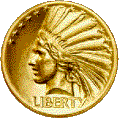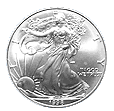

I. Introduction
Coins and Coin Collecting,
Sometimes referred to by the single term Numismatics (from greek nomisma,"coin"), meaning the study and collection of coins and paper money bearing a country's official designs and monetary value, and also tokens, medals, and similar articles. for centuries, all but the very lowest denominations of coins had intrinsic value; That is, they contained Gold or Silver equal to their face value. Most nations, however, have replaced their precious-metal coins with coins made from inexpensive metals, having face value only.
II. History of Coinage
In ancient times, pieces of gold and silver were widely used in trade, being exchanged for other goods by weight. The weight and purity of the metal had to be tested every time it changed hands. In Asia minor, sometime around 600bc, the lydians hit upon the idea of shaping electrum, a natural alloy of Gold and Silver, into bean-shaped lumps of fixed weight and purity and stamping them with official symbols. By 550bc, the practice of striking coins was established in all the important trading cities throughout the known world. Although most Greek coins portrayed gods or goddesses, coins of the Roman empire (from about the 1st century bc to the 5th century ad) offered portraits of the Emperors. Because islam prohibits graven images, Arabic coins (at least before the 20th century) were restricted to inscriptions, often from the qur'an (Koran), the sacred scripture of islam, on obverse and reverse.
From earliest times, Silver was the principal metal for trade in the far east. It was cast in cakes or ingots of various forms marked with inscriptions giving the name of the merchant and the denomination and purity of the piece of metal. Regular machine-made round coins of the Western type did not appear until 1870 in Japan and 1889 in China.
Except for the orient, most coins throughout the world were handstruck until about 1500. The Italians are credited with devising mills for punching out uniformly round, blank metal disks, or planchets, and screw presses for impressing designs onto them. The discovery of the Americas, with their wealth of precious metals, led to greatly increased coin production, including large Silver pieces. During this period almost every kingdom, duchy, principality, and free city in the Western world issued its own coins.
Minting of coins in the new world began in 1535 in Mexico City, after the Spanish conquest. The British government did not provide its North American colonists with a coinage of their own; Therefore, although the colonists used British money, reckoning values in Pounds, Shillings, and Pence, they also usedFfrench, Dutch, German, and assorted Spanish coins.
An official mint in the United States was established in 1792, and coinage began in 1793. In addition to the denominations still in use today, the mint over the years produced ½-cent, 2-cent, 3-cent, and 20-cent pieces as well as Gold coins ranging from $2.50 to $20. The original 5-cent pieces were half-dimes made of Silver. With a few exceptions, U.S. coins carry a year date and a mint mark to show where they were produced. the last regular issue gold coins were struck in 1933, and the last fine silver coins were dated 1964. since 1982, however, the United States has issued Silver and Gold Commemorative coins to mark certain memorable events such as the 23rd Olympic games in Los Angeles (1984), the centennial of the Statue of Liberty (1986), and the bicentennial of the U.S. Constitution (1987). Since 1986 the U.S. Mint has issued Gold and Silver Bullion coins, principally for precious metal investors.
All early U.S. Coins had a personification of liberty on the obverse; On the 1859 cent this figure was depicted with a Native American in a feathered headdress. A design featuring a representation of a Native American came into use on the $2.50 and $5 Gold pieces of 1908 and on the 5-cent pieces (made of copper and nickel) of 1913. the practice of picturing deceased presidents on u.s. coins dates from 1909, the centennial of Abraham Lincoln's birth. A series of 50 types of special commemorative Silver coins was issued between 1892 and 1954; Many carried likenesses of historical figures other than presidents, including the explorer Daniel Boone and the showman P. T. Barnum. The first regular-issue coin with such a design was the Benjamin Franklin Half-Dollar (honoring the American Statesman), issued from 1948 to 1963.
III. Coin Collecting
Coins old and new have a special attraction for many people, professionals as well as amateur hobbyists; Estimates of the number of active collectors worldwide range into the millions. Scholars regard coins as mirrors of history, studying coin portraits of contemporary Monarchs—some famous, others scarcely known except for coins—and the inscriptions and designs that often refer to important events. even analyzing the purity of the metal from which a coin was made can provide an insight into the economics of its time. amateur Collectors, often called Numismatists, enjoy coins for their beauty, their rarity, and the stories behind them. Added to this is the excitement of searching for and finding specific coins, or the challenge of identifying an unfamiliar item. Numismatists also enjoy arranging and displaying a collection. Most appealing of all, perhaps, is the possibility of finding rare coins for a bargain price and the hope that coins in a collection will in time increase in worth.
The market value of any coin—that is, the price a dealer would charge for it—is determined by supply and demand—the available quantity of a coin and the number of collectors and degree of interest they have in owning it. Once a coin becomes recognized as a rarity, its value frequently increases every time it changes hands. A key element in the value of any coin is its state of preservation. A specimen in perfect condition, just as it left the mint, may be worth many times as much as the same coin in average used condition. Mutilation or damage greatly reduces the value of a coin. Collectors and dealers use a point system as well as a set of terms to describe the condition of coins: Uncirculated or Mint State (ms 70-60), about Uncirculated (au 55-50), Extremely Fine (ef 45-40), Very Fine (vf 30-20), Fine (f 12), Very Good (vg 8), and Good (g 4).
Collectors are likely to start with coins of their own countries because of their availability. With this kind of collection, every date, mint mark, and variation in design is counted as a different coin; The goal is not only to acquire one of every variety issued but also continually to upgrade the condition of the coins already found. The number of coins to be found in circulation is, however, fairly restricted, and a collector must resort to trading or buying to fill in such a series.
Another popular form of collecting is assembling types of older coins. Instead of trying to have a specimen of every date and variety of a series, the collector obtains a single coin to represent each "face different" series. This kind of collection is particularly interesting because every coin is different and has its own history.
If a Numismatist turns to coins of other countries, many thousands of specimens become available. Series collections or type collections of any country that interests the collector can be formed. Specific dates and varieties of foreign coins are much harder to find even in dealers' stocks, so a Numismatist may try putting together a collection of one coin each of many different countries, or only commemorative coins.
Topical or Thematic collecting has also become popular. In this kind of collection the coins are related to one another on the basis of their design and the people or objects shown. Animals, Plants, Ships, Maps, Buildings, and religious motifs are well represented on coins; By watching the new issues of the world for appropriate designs, additions to a collection can be made.
When deciding on the purchase of expensive coins, collectors must do the same kind of research necessary for any other investment. The current market value for the item, how readily and for what kind of price it can be resold, and its potential appreciation must be determined. Above all the collector must be knowledgeable enough to know whether a coin is genuine, or must have confidence that the dealer does.
Coin catalogs give some idea of current prices realized for various coins; Dealer advertisements in the special coin magazines and newspapers are, however, usually more up to date. Coin auctions are an important feature of the major Numismatic conventions. Catalogs of the items to be sold are issued ahead of time, and lists of the prices at which the items were sold can often be obtained afterward. Conventions may have tables where Numismatists can consider the offerings of many dealers. To assess future trends the collectors need to meet with other enthusiasts, perhaps by joining a local club.
The most elegant way to display a coin collection is in a cabinet with pull-out trays. The most convenient way, on the other hand, is to use an album system with plastic pages that hold individual cardboard coin mounts. The best way to deal with large numbers of coins is to use small, standard-size coin envelopes filed in boxes. The same precautions taken for other valuables must be used to safeguard a coin collection.
IV. Coin Associations and Museums
The American Numismatic Association, founded in 1891 to promote exchange of knowledge, is the largest organization of coin collectors in the world; Headquarters is in Colorado Springs, Colorado. Several special museum collections in the United States are also devoted to coins, among them those of the smithsonian institution, Washington, D.C., and the American Numismatic Society, New York City.
"coins and coin collecting," microsoft® encarta® online encyclopedia 2000 http://encarta.msn.com © 1997-2000 microsoft corporation. all rights reserved. © 1993-2000 microsoft corporation. all rights reserved.
Home | Coins | Commemorative Coins | State Quarters | State Quarter Supplies & Holders | 1oz Silver Statehood Quaters | U.S. Proof Sets | U.S. Mint Sets | American Silver Eagles- Proof & Unc | Coin Collecting Supplies | Coin Value Guides | Magnifying Glasses | Coin Bezels | Gold and Silver Bullion | Coin Dealers | History of Coins | Highland Mint Coins | Pictures of our Store | Our Staff | Contact Us |
Question or Comments - Click Here to Email !
